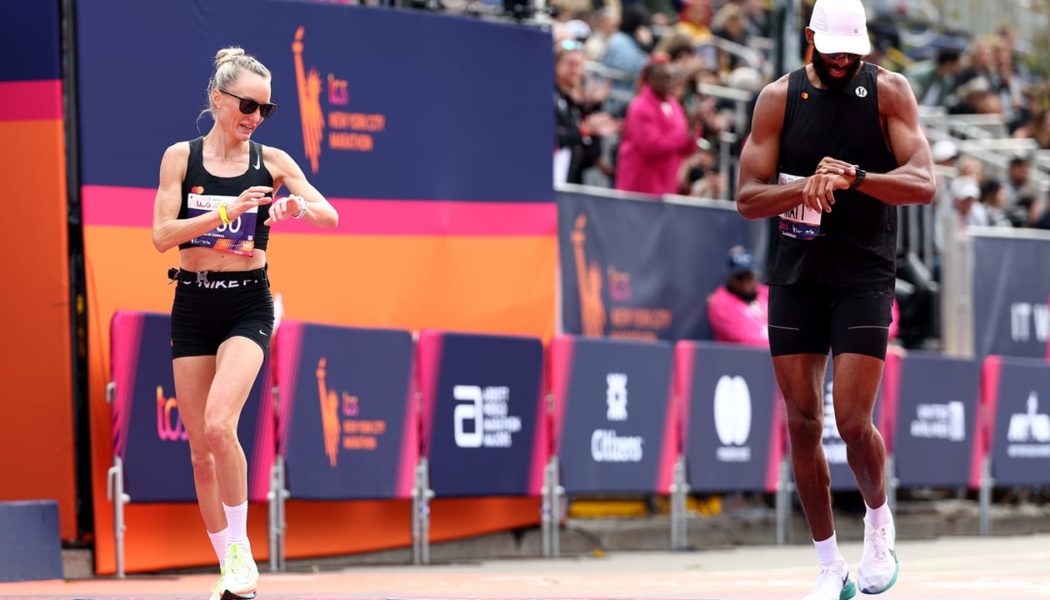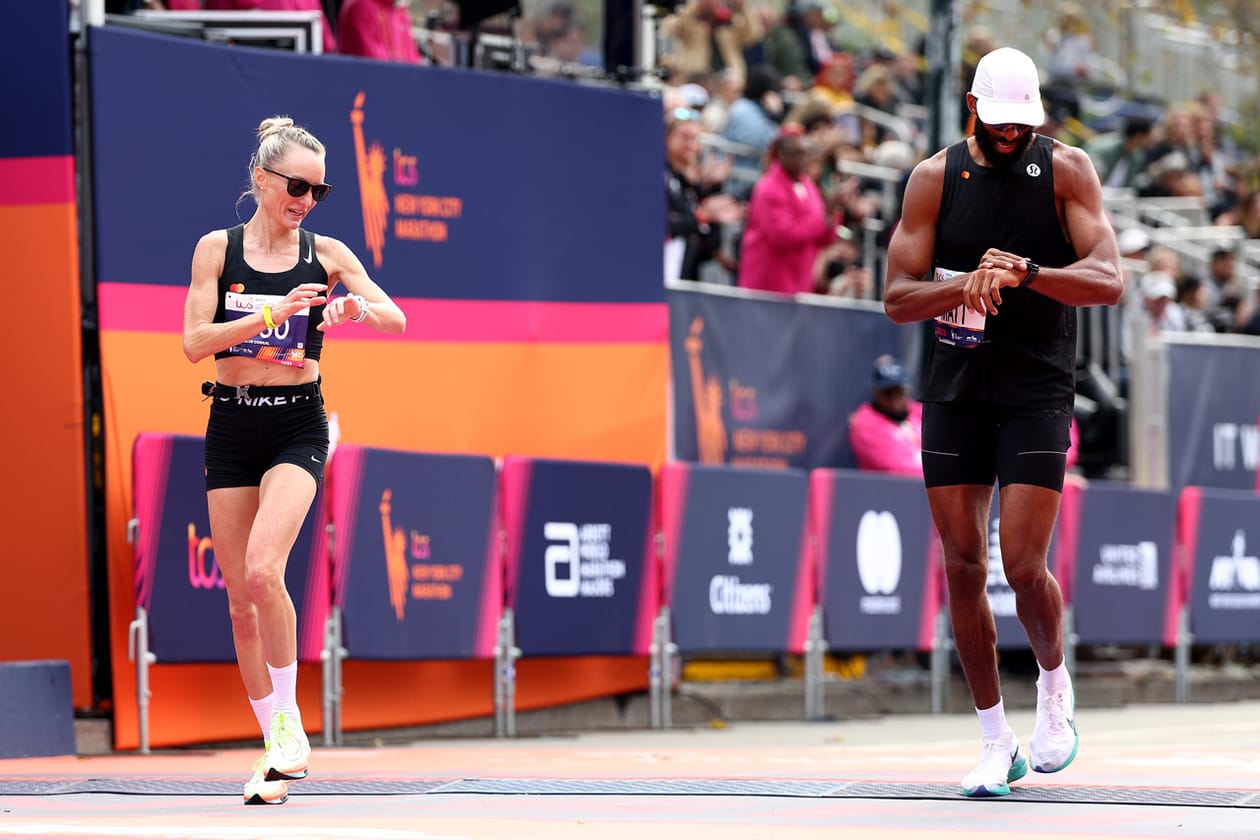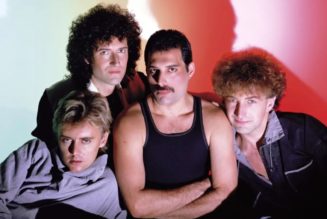Shalane Flanagan knows a thing or two about the New York City Marathon. She won the race in 2017 — becoming the first American woman to win in 40 years — took home second place in 2010 and had a victory lap in 2018, when she secured third place in her final competitive race. Though she’s retired from competitive running, now coaching track and field at the University of Oregon, she remains plugged directly into marathon culture, serving as both an ambassador for the event and one of the faces of MasterCard’s “Priceless Start” program, which enables a few lucky runners to begin the New York City Marathon well before the crowds and even before the professional runners.
Ahead of the 2024 New York City Marathon, Flanagan took a few minutes away from her packed training schedule to discuss shifts in marathon culture, what running a “successful” race looks like, how to stay mentally tough when you hit a marathon’s infamous “wall” and much more.
Race week is here. What’s the energy like and what’s special about the vibe in NYC as opposed to other marathon majors?
Back in 2021 I did this fun project I called “Project Eclipse,” essentially running all of the marathon majors except for Tokyo in one year, so I got to experience the “feel” of each in a very short period. Of course, I’ve always seen the New York City Marathon through rose-colored glasses because I always performed well there while running professionally, but after I got to step back and compare it with the other experiences, it easily came out on top. It’s a genuinely passionate city and race, with an eclectic mix of people and experiences. The connection between the runners and the supporters feels really intimate.
What are the best and most challenging elements of the course? Do you think there’s a sneakily challenging part that doesn’t get enough attention?
I love the bridges: they’re both the best and the hardest part. It’s so quiet. You’re alone with your thoughts and all you hear is the pitter-patter of feet. That dynamic of going from loud crowds to quiet bridges and back again is so unique.
Regarding the trickiest bit, a lot of people know about how the race finishes in the park, and how the supporters are pretty much right on top of you. But what not as many people may know is that part of the race also has some of the entire course’s most technical aspects. When you get to the last 10K, the last 5K of any marathon, it begins to get extremely difficult. Especially in New York, as you’re going up a long, gradual hill right outside of the park. Then, you get in the park, and you’re like, “OK, 5K to go, let’s do this,” — but that part of the park is really technical with a lot of rolling hills, which makes it hard to hit your tangent lines and run the shortest distance possible with minimal side-to-side movement.
You mentioned hitting that wall towards the end of the race. No matter how experienced you are you’re going to hit it, so what’s your best piece of advice for pushing through when you do?
I think the key is not freaking out and giving yourself a little bit of grace. It’s okay to slow down a bit and recalibrate, figure out if you need more water, more gels. Figure out if it’s a fueling thing, or if it’s a pain thing, like if you’re starting to get achy. You need to push through, but at the same time it’s important to respect your body and think about why you’re running.
Take those thoughts about why you’re running, and take yourself into a good headspace. I like to reflect on my training, specifically a hard training moment that I conquered in the lead-up to the race, one that prepared me for a moment like this. It’s a little psychology twist, envisioning the sessions where you were really strong. It also helps to think about your “why.” Are you running for yourself? Someone else? Running to be a good role model for your kids? Whatever that reason is, bring it to light and focus on it so you don’t have to expend energy thinking about what hurts.
“It’s a huge accomplishment to even make it to the start line, let alone the finish line.”
What does a “successful” marathon look like to you, moreso from a psychological sense than a pure speed sense?
Everyone gets to determine what success means to them. So from the outside, no one can say if it was successful or not, because you’re the only one who really knows what you did and how you executed. If you were really struggling and you overcame some of those mental demons that were telling you to slow down or quit, that’s success in my mind. It’s a huge accomplishment to even make it to the start line, let alone the finish line. I feel like even being there on that day is success. Celebrating that you’re alive, that you get to run this race, you don’t have to run this race.
Over 120,000 people entered to run the New York City Marathon last year, and over 50,000 finished. The sheer increase in number of runners is impressive, but what are the other biggest shifts you’ve seen in marathon culture over the last five years?
I was honestly astonished to learn how many people apply to the marathon and how hard it is to get in. I kind of took it for granted when I was a professional athlete, but it’s such a privilege to get to do it. I think the biggest shift I’ve seen outside of the elite running world is that it’s an activity a lot of people will do in a group now, or they’ll take a vacation centered around running a marathon. People don’t seem as intimidated by the distance anymore, and it’s interestingly become more of a societal norm to run one, train for one. People aren’t like “What are you doing?” anymore [laughs].
You retired from running professionally five years ago. How has your relationship to the sport changed and evolved since then?
It’s actually much more enjoyable for me now that it’s not my job. It’s been a very different experience, and I can really soak up the atmosphere now. The last time I ran competitively was actually the New York City Marathon in 2019 — I placed third and retired right afterwards. Since then, I’ve gotten to come back and do it on behalf of MasterCard, and it’s been amazing to really enjoy the sights, the sounds, the cheers. When it was my job, I had to have tunnel vision: all I could think about was winning, performance, executing.
Now, my running is honestly more for my mental health. I joke with the athletes that I coach at the University of Oregon that running is my drug of choice. My day feels incomplete if I don’t take a run, and I’m a better coach, better mom, better person when I do. I feel very privileged that I’m healthy and can continue to run.
“Any time your mind and body allow you to complete a marathon, it’s worth celebrating.”
Can you describe the feeling of finishing a marathon? Is it still incredible, even after all the ones you’ve ran, finished, won?
Any time your mind and body allow you to complete a marathon, it’s worth celebrating. There’s nothing easy about it, even if you’re really fit. Finishing is very emotional. Sometimes I still get caught off guard by how emotional I feel when I cross the finish line, because I see other runners finishing and how much it means to them to do so. That makes me realize how much running has given to my life, and shows me how running can affect people so deeply and in such a postive way.
Cranking it back from the last step to the first one, the MasterCard Priceless Start lets a few lucky runners start really early, even before the pros. You’ve taken part in it several times — what are the unique challenges and rewards of being out on the course so early?
You’re in this really cool sandwich where the handcycle and wheelchair racers are out in front of you, but you know the pros are stalking you from behind. The first couple miles are obviously a bit quieter because you’re so early, but then when the pros catch up and pass you it’s a really unique experience. You get to see the dynamic of the race unfolding right next to you. You’re so close you can literally be flicked by their sweat. Nobody else gets that experience.
One final question: do you think we’ll see a two-hour marathon major in our lifetimes?
Absolutley. Some runners are already knocking on the door, and we’ve seen what people are capable of with the Breaking2 initative. We’re right there and it’s pretty incredible.





![Who Should Skrillex Collaborate with on His Next Album? [POLL]](https://www.wazupnaija.com/wp-content/uploads/2020/07/who-should-skrillex-collaborate-with-on-his-next-album-poll-327x219.jpg)




